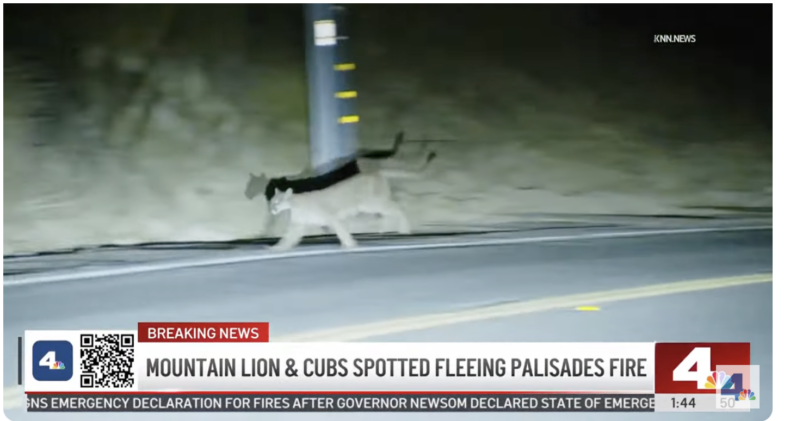
I had tickets to fly to LA at the end of the week for mountain lion research where I’d meet with wildlife biologists, follow cats in the Santa Monica mountains by radio collar telemetry, and take a tour of the nearly complete Wallis Annenberg Wildlife Crossing over the 101. That plan went out the window with these horrific fires. Contacts dropped out to deal with on the ground emergencies and I quickly found that couches I’d been hoping to sleep on were already taken. None of the collared cats were caught in the fires, but their already fragmented urban-edge habitats are further fractured and reduced.
For a manuscript I’m writing on mountain lions, this is a week I can’t afford to lose. I changed flights to Miami where another marginal population lives in southern Florida. In the Southeast they are called panthers, same species as the ones in LA, as the ones that still exist anywhere in the Americas. Unlike the cats of LA who get infusions of genes from surrounding mountain ranges in Mexico and the US, panthers in Florida are completely isolated. Fifty years ago they were down to between ten and thirty individuals living in the swamplands and savanna grasses of the southern part of the state. They are now up to a couple hundred, still located in the bottom of the sock of Florida, still dangerously endangered, and still more isolated than any other Puma concolor population in the world.
Meanwhile in LA, mountain lions are taking it hard, pushed out by fires, killed frequently while crossing interstates. Those with collars respond to fires by being out more during the day with nocturnal habits upended. Their patterns change as territories are reorganized and new ground is explored, which includes unfamiliar streets and backyards. Cats that got out of the way of fires have to keep going.
Urban areas are crap for mountain lions. They’ll take them if they have to, but the pitfalls are many, mortality high. Add fires, double the crap. After previous fires in LA, they’ve tended to engage in more risk-taking behaviors because their territories were cut in half or obliterated. Seen more often by people, they show up on more door cams as they look for prey and new places to den.
A big fire ripped through the Santa Monica mountains in 2018 and one mountain lion corpse was found several weeks later starved and with burnt paws. Seventeen other cats with GPS locators were directly impacted by the fire and afterward they avoided burned areas while increasing daytime and urban activities. A study found that the distances they ranged went from a monthly 250 kilometers to 390 after the fire, increasing overlap with both each other, which can be dangerous, and with humans, which can be more dangerous. Freeway crossings, the greatest threat they face, went from 3 to 5 per month.
I still had the tickets to fly to LA and I spent a few days trying to justify keeping them, thinking it would be a perfect time to lurk through smoldering chaparral to find burned out animal trails and write about the perils faced by these isolated populations. It would be too bleak, though. I’d be a disaster tourist taking a couch away from someone who really needs it.
Don’t get me wrong, Florida has its bleakness. In 2024, of the 33 panthers known to have died in the state, 26 were killed by cars. The fires they have to get away from are the brightly populated coasts to the east and west, several million people living tightly around them. Telemetry data shows where they tend to hang out: grass, palm, and pine highlands surrounded by swamps with cypress and bromeliads. I’ll have a rechargeable, high-lumen flashlight that at night should distinguish between the orange reflection of alligator eyes and the yellow to greenish gold of panthers.
In a sense I’m fleeing the fires, too, an outer ring of effects. A radio collar around my neck would put another dot in a dataset. Another opportunist has been pushed out by a disaster, boarding a flight at the end of the week with notebooks and swamp-walking gear to go where I hadn’t expected to be.
Photo: mother mountain lion on the run (cubs shortly behind her) NBC4 Los Angeles, 1 am, Jan. 9, 2025.
As always, very informative and sometimes heart wrenching.
I feel sad for all the wildlife that had to escape the fires, if they even had a chance
“It would be too bleak, though.” Too bleak for what? For earth writers, Bleak is home-ground.